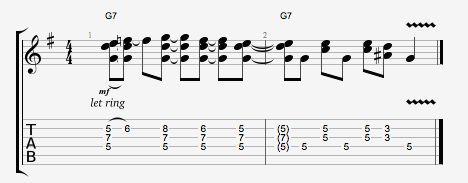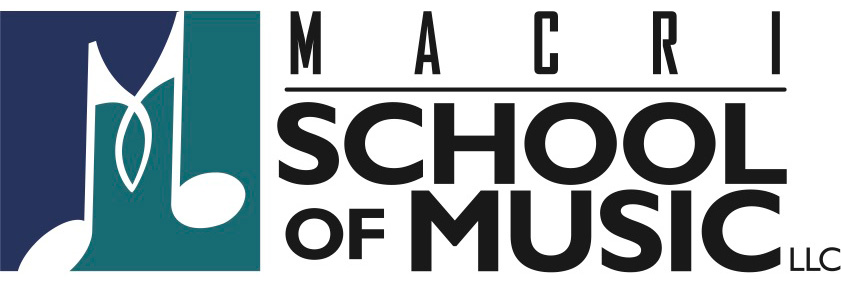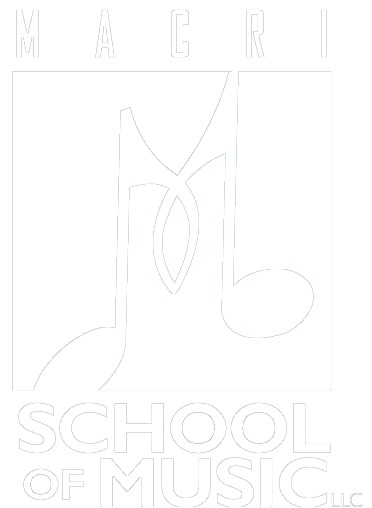Double Stops For Guitar Pt. 2
This is the second installment of my lesson on double stops. For those who missed the first half of the lesson feel free to go here for a review. This time around we will check out some blues based double stops and delve into the Curtis Mayfield /Jimi Hendrix style of rhythm guitar playing.
Ex. 1. is a double stop in the key of E and can be heard in many variations by a whole host of blues guitar players. My inspiration for this is Eric Clapton’s version of the Freddie King classic “Hideaway”. This song is featured on the John Mayall Bluesbreakers w/ Eric Clapton album a.k.a the “Beano” album. This album is a masterpiece and hugely influential to everyone who followed this period of British blues guitar. The double stop is achieved by playing the B on the 4th fret 3rd stg and the D on the 3rd fret 2nd stg, this is the 5th and b7th of the E7 chord respectively. I am sliding from a whole step below on the downbeat of each group of eight note triplets. The slide provides feel and authenticity to this lick and gives it momentum. The second bar resolves down in Em pentatonic and ends with a trill from the open G to the G# on the 3rd string.

Ex. 2. is one of the most famous and influential guitar riffs of all time. It is quite possible that this double stop lick created rock-n-roll and everyone who plays guitar has paid homage to it at one time or another. Chuck Berry’s “Johnny B. Goode” is a bona fide classic and it is quite challenging if one tries to nail all its nuances. The original is in the Key of Bb and starts with a pickup in Bb major pentatonic followed by a full measure of double stops in 4ths on the 1st & 2nd stg with the notes F and Bb. Chuck then combined major & minor pentatonic in the next measure with a descending pattern that includes the major and minor 3rd as well as a b7th. There is another double stop with F & Bb but this time they are played on the 4th and 5th string. The maj 3rd of Bb is tagged in the final measure of my example as well as two more double stops and this time a min 3rd interval is struck with the D & F and another 4th with D & G.

Ex. 3. is a Robben Ford / David Grissom inspired lick in the Key Of G. I recommend using hybrid picking ( pick & fingers ) to get the notes to ring together and achieve a nice warm tone. To start off play a G & D on the 4th and 3rd stgs, these two notes will ring throughout the first measure. Next we will alternate different notes on the B stg to get some different intervals. I am ascending up from E, F , G – which are the 6th, b7th, and octave of our G7 chord, I then descend back down. The next measure uses two third double stops toggling back and forth between the G on the 4th stg. This sequence is moveable so try it in different keys to see what suits your ears the best. Open strings are also great for these types of lines but that limits what keys you can play them in.

Ex. 4. Chances are you have heard Jimi Hendrix’s “Bold As Love ” Or Stevie Ray Vaughan’s “Lenny”. What you might not know is that style of r&b guitar was pioneered by Curtis Mayfield. Curtis used a unique F# tuning but this example from the 2nd fill in “People Get Ready” is written in standard tuning in the Key of Db. This line starts off with a pickup on a Db maj triad and then a 3rd double stop on the G & B stg. Try holding this down throughout the 1st measure until the single on the 4th beat. After the Db double stop Curtis hammers onto a Gb and back to the Db followed by a 4th on the A & D stg, this F & Bb implies the vi chord Bbm. The next measure has a beautiful nod to the IV chord which is Gb. The Db is played on the 5th stg, with the Ab on the 4th stg and the Db on the 3rd stg. The Bb is hammered on from the Ab and then there two 4th dbl stps which imply a I-V change and then a resolve back to the I chord Db on the 6th stg. This is subtle but beautiful playing and a perfect example of the versatility of double stops.

Ex. 5. is an excerpt from Jimi Hendrix’s “Little Wing” solo. Hendrix has so many wonderful double stop licks it is difficult to choose one but I thought this provided a few key shapes that Jimi favored. This lick starts in the 7th measure of the solo and begins with a double stop bend on the 3rd stg while holding down a note on the 1st stg. This implies the G and Fsus2 chord because the bend is to the B( maj 3rd) of the G chord and the fretted note is the root. The G is then played on the 3rd stg with the F on the 1st stg and that creates the Fsus2. The next measure is a key double stop shape Jimi played in lots of tunes and it is for the C chord. While holding a D & G on the 3rd and 2nd stg he hammers onto the E, also on the 3rd stg and then tags the C note on the D stg. This creates a Csus2 sound for the C chord because of the D being added. For the D chord Jimi pulls out all the stops and plays several different shapes creating a Dsus4 and Dsus9 sound. Try holding the E & A on the 3rd and 2nd stg down for the whole lick while hammering on and pulling off with the 3rd finger and pinky. The last measure is a whammy bar dive with natural harmonics played on the 12th fret.



